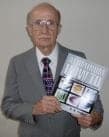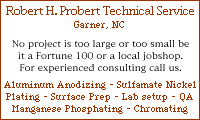
-----
White discoloration of black anodized aluminum - Type 3 Class 2 anodize per Mil-A-8625
Q. I am a Process Engineer at a contract EMS and I have a problem. I have some FR-4 multilayer circuit boards that are bonded to a
MIL-A-8625 / MIL-PRF-8625
[⇦ this spec on DLA] Type II Black Anodized heatsink. We are seeing some intermittent discoloration of aluminum heatsinks after a defluxing cleaning operation. I am running them through a semi-aqueous cleaning solution , Kyzen Aquanox A4520W. It is a mild alkaline solution- a saponifier to remove rosin soldering fluxes from the circuit boards
We spoke with the company doing the anodize and they suggested a duplex seal. Their normal sealing process is nickel acetate and they are following this up with a hot DI water seal for 30 minutes. What process controls can be done on the process which might give some insight to the anodize and sealing processes. What things should be monitored and controlled in the sealing process
I got a sample from our supplier. It received a nickel acetate (?) seal followed by a hot DI water seal. I took a sample and ran it through our semi-aqueous cleaning solution, Kyzen Aquanox A4520W several times. The solution is 150F with a pH of 10. Each wash pass subjects the wash sample to an exposure time of 5 minutes. Ran one of the two anodize heatsinks from Polymetals through the NPI wash today at 0.5 FPM, 150F. After 4 iterations saw some discoloration and photos are after six wash passes. What is interesting is that there is much more discoloration on the top surface (half of board was taped off) of heatsink than on the bottom. Maybe related to more time for the solution to pool and contact the top versus the bottom of the heatsink.
Does anyone experienced this issue before. I took one of the discolored samples and it passed anodize coating weight and corrosion resistance. The anodize seems good but there is some sort of discoloration in the dye. Any ideas of any drag out or other things which might effect a nickel sealing process?
electronics - Tampa, Florida
2007
|
|
Aluminum metal and Aluminum Oxide and Hydrated Aluminum Oxide (the seal), are all attacked to some varying degree depending on time, temperature and concentration of ANY alkali, more so with heat, and certainly including Alconox ⇦ on eBay or Amazon [affil link] , Florida chloride-bearing water, etc. . .  Robert H Probert Robert H Probert Technical Services Garner, North Carolina  A. Anodize is attacked by high pH solutions -- the higher the pH, time & Temperature, the greater the attack. Type, Class, dyeing, sealing, etc. are only minor details. Non-etching soak cleaners for aluminum are buffered to remain below about pH 9.1. See - Goleta, California Rest in peace, Ken. Thank you for your hard work which the finishing world, and we at finishing.com, continue to benefit from. A. I am unaware of any exotic solutions to your problem that may be out there. - Navarre, Florida |
Thanks for the response to my question about anodize. I understand that alkaline cleaners- modified saponifier- and anodize aluminum don't mix well. The problem I have is the solder paste flux are difficult to clean and are a rosin base and require a saponifier to remove from the board. The board is bonded to an aluminum heatsink.
What I do not understand is why some pieces do not discolor after a total exposure time of 5 min 30 sec (four passes) at 150F. Other parts do discolor.
The other thing that is perplexing is that I have tried three different chemistries from two vendors on four different in line wash systems. I took one sample and cut it into 8 pieces. On some pieces the anodize developed a dull matte look to the anodize, other pieces developed a white hazy appearance.
What type of questions should I ask the anodize provider about the raw material, pretreatment and sealer conditions? Could changes in the pore size possibly effect the chemical resistance changes I have seen. I will try to at least reduce the temperature from 150 to 130 F and increase the wash belt speed. The effects I see seem to be cumulative- a single pass cleaning cycle doesn't effect the coating appearance but after 3-5 cycles the effects are noticeable.
- Tampa Florida
A. Hi there,
Why not bond the heat sink to the board after cleaning the board.
- Durban, South Africa
A. In lieu of anodizing, consider e-coated aluminum. It is non-conductive, non-corrosive and up to 10 microns thick. on any raw aluminum.
Mike Dywan- Phoenix, Arizona
Q, A, or Comment on THIS thread -or- Start a NEW Thread